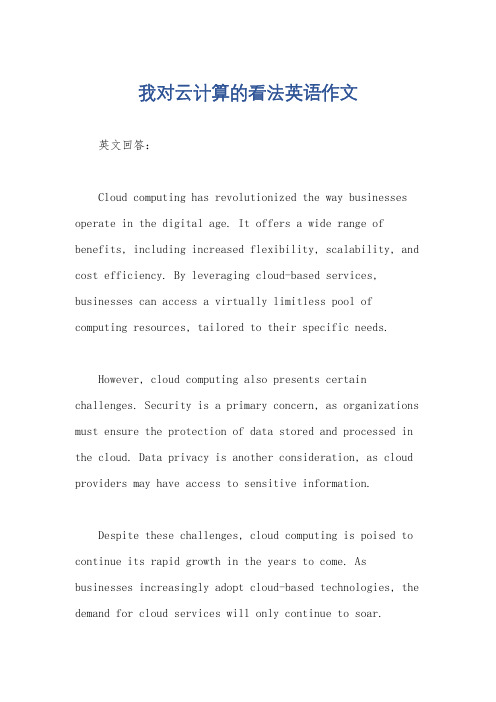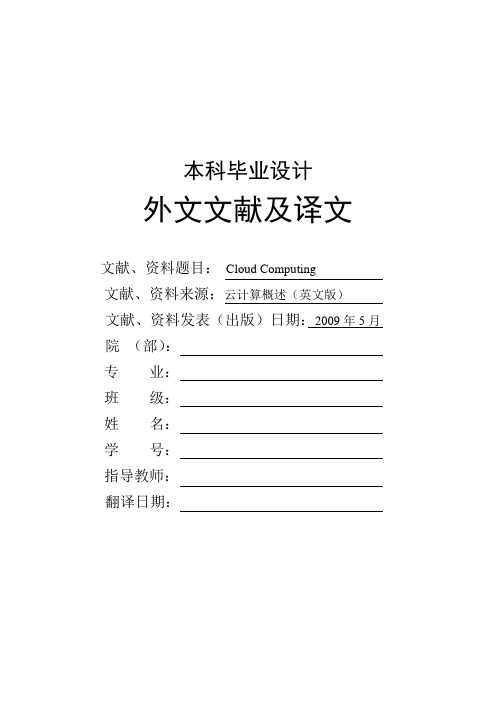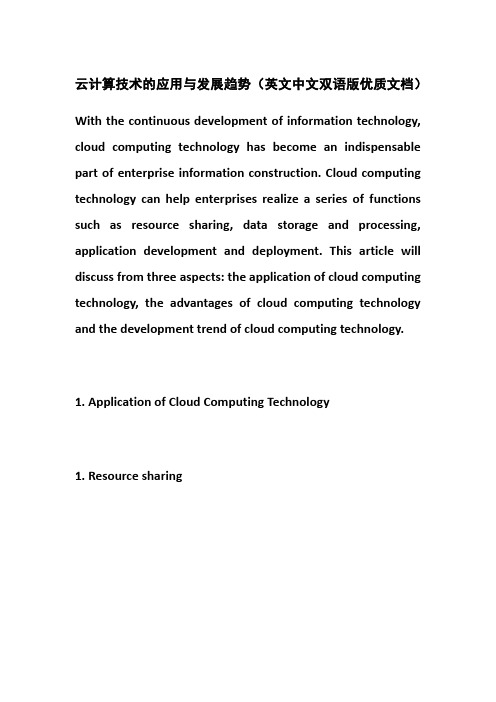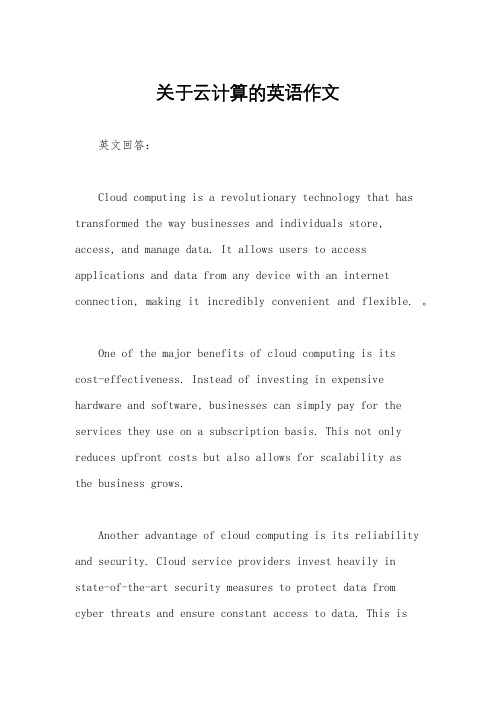理工类学术英语翻译Text 4 云计算的安全优势
学术英语理工版课文翻译

Text 1 电脑黑客如何进入电脑这好像是一个直接的问题,但是内涵很复杂,答案绝不简单,如果随便地回答,那么黑客通过利用弱点进入目标电脑系统。
但是为了提供更多细节,我们还是从头说起。
“hacker”这个词在意义和解释上都很有争议。
有些人说ha ckers(开路人) 是好人,他们只是推动了知识的边界,并没造成什么伤害(至少不是故意的),而crack er s (打砸者)是真正的坏蛋。
这种争论没有什么效果,如果是为了这种讨论的目的,术语“未授权的使用者”(UU)就足够用了。
这个术语包含了所有不同类型的人,从那些参与有组织犯罪行为的人到那些内部人士,他们突破了在系统中被授予的权限。
接下来我们探讨一下“进入”电脑意味着什么。
这可以指获得电脑系统储存的内容,获得系统的处理能力,或者捕获系统之间交流的信息。
每种攻击都需要不同的技巧,以不同的弱点为目标。
那么“未授权的使用者”利用的是什么?弱点存在于每个系统中,并且有两种弱点:已知的和未知的。
已知的弱点通常因为需要某些能力而存在。
比如,为了某个商业过程,你需要不同的人使用一个系统,你就有一个已知的弱点:使用者。
另一个已知弱点的例子是通过互联网交流的能力,为了具备这个能力,你要给未知和不被信任的实体开通一条路径。
未知的弱点是系统的拥有者或操作者所不了解的,可能是劣质工程的结果,或者是某些被需要的能力产生的非故意的结果。
按照定义,弱点可能被利用。
这些弱点可以是低级的密码保护,也可以是让电脑开着,让办公室的访客可以利用。
只要坐在接待员的桌前,用他的电脑获得需要的信息,就有超过一种技术被利用。
低级的密码(比如,用户名“Joe Smith”, 密码也是“Joe Smith”)也是接近电脑的丰富的来源:密码破译程序可以很容易在几分钟内确认字典中的单词、姓名,甚至常见短语。
介绍云计算的英语作文

介绍云计算的英语作文Cloud computing is a revolutionary concept that has transformed the way we access and process data. It refers to the delivery of computing services over the internet, which includes servers, storage, databases, networking, software, analytics, and intelligence. This essay will explore the fundamentals of cloud computing, its benefits, and itsvarious deployment models.Fundamentals of Cloud ComputingCloud computing operates on a simple principle: instead of having a physical server or a local storage device, users can access a shared pool of computing resources over the internet. This is similar to how electricity is provided as a utility, where you only pay for what you use. The infrastructure is maintained by a cloud provider, which handles everything from data storage to processing power.Benefits of Cloud Computing1. Cost Efficiency: One of the most significant advantages of cloud computing is cost savings. It eliminates the need for businesses to invest in expensive hardware and software, as they can rent these resources as needed.2. Scalability: Cloud services can be easily scaled up ordown based on the demand. This flexibility allows businessesto handle sudden spikes in traffic without worrying about infrastructure limitations.3. Accessibility: Data and applications are accessible from anywhere with an internet connection, which is particularly beneficial for remote teams and global enterprises.4. Reliability and Redundancy: Cloud providers typicallyoffer high levels of reliability and redundancy, ensuringthat your data is backed up and always available.5. Maintenance and Updates: Cloud providers are responsiblefor maintaining the servers and software, which means that users do not have to worry about updates and patches.Deployment ModelsThere are three primary deployment models for cloud computing:1. Public Cloud: This is the most common model where services are provided over the public internet. Amazon Web Services (AWS), Microsoft Azure, and Google Cloud Platform are examples of public cloud providers.2. Private Cloud: In this model, the cloud infrastructure is operated solely for a single organization, which can be managed by the organization itself or a third-party service provider.3. Hybrid Cloud: This combines elements of both public and private clouds, allowing for greater flexibility and theability to move workloads between the two environments. ConclusionCloud computing has become an integral part of modern IT infrastructure. It offers a range of benefits that make it an attractive option for businesses of all sizes. As technology continues to evolve, the adoption of cloud computing is expected to grow, further expanding the capabilities and services available to users around the world.。
关于云计算的英语作文

关于云计算的英语作文英文回答:Cloud computing has revolutionized the way businesses and individuals store, process, and access data and applications. As a result, there are multiple benefits of cloud computing, including improved flexibility, reduced costs, increased security, enhanced collaboration, and innovative services.Flexibility is one of the key advantages of cloud computing. It allows users to access their data and applications from anywhere with an internet connection. This makes it easier for businesses to operate remotely and for individuals to work from home.Reduced costs are another advantage of cloud computing. Businesses can avoid the upfront costs of purchasing and maintaining their own IT infrastructure. Instead, they can pay for cloud services on a pay-as-you-go basis.Increased security is another key benefit of cloud computing. Cloud providers have invested heavily insecurity measures to protect their customers' data. This makes cloud computing a more secure option than storingdata on-premises.Enhanced collaboration is another advantage of cloud computing. Cloud-based applications make it easier forteams to collaborate on projects. This is because cloud applications can be accessed from anywhere, and they allow users to share files and collaborate in real-time.Innovative services are another key benefit of cloud computing. Cloud providers are constantly developing new services, such as artificial intelligence, machine learning, and data analytics. These services can help businesses improve their operations and make better decisions.Overall, cloud computing offers a number of benefitsthat can help businesses and individuals improve their operations, reduce costs, and increase innovation.中文回答:云计算的优势。
云计算的优势与劣势分析

云计算的优势与劣势分析云计算(Cloud Computing)是一种通过互联网提供计算服务的模式,它以虚拟化技术为基础,通过将计算资源、存储资源和应用程序等进行集中管理和分配,为用户提供灵活、高效、可扩展的计算能力。
云计算已经成为当今信息技术领域的热门话题,被广泛应用于企业、教育、医疗等各个行业。
本文将就云计算的优势与劣势进行分析。
一、优势分析1. 灵活性与可扩展性:云计算提供了灵活的资源分配和调整机制,用户可以根据实际需求随时增加或减少计算资源,无需购买昂贵的硬件设备。
这种灵活性使得企业能够根据业务需求快速扩展或缩减计算能力,大大提高了业务的敏捷性和竞争力。
2. 成本效益:云计算采用按需付费的模式,用户只需支付实际使用的资源,无需投资大量资金购买和维护硬件设备。
这种模式可以降低企业的IT成本,提高资金利用效率。
同时,云计算的资源共享机制也能够降低整体的运营成本。
3. 可靠性与可用性:云计算提供了高可靠性和高可用性的服务。
云计算平台通常采用分布式架构和冗余备份机制,保证了数据和应用程序的安全性和可靠性。
即使某个节点发生故障,也能够通过其他节点继续提供服务,从而降低了服务中断的风险。
4. 数据安全与备份:云计算平台通常配备有成熟的安全机制,包括身份验证、访问控制、数据加密等,保护用户数据的安全性。
同时,云计算平台会定期对数据进行备份,即使发生数据丢失或灾难事件,用户的数据也能够得到有效的恢复和保护。
二、劣势分析1. 依赖网络:云计算是基于互联网的服务模式,用户需要通过网络访问云计算平台。
如果网络出现故障或带宽不足,会导致用户无法正常使用云计算服务,影响业务的进行。
此外,网络的不稳定性也会对数据传输和应用程序的响应速度产生影响。
2. 隐私与安全风险:云计算平台通常需要用户将数据存储在云端,这就带来了隐私和安全的风险。
虽然云计算平台会采取一系列的安全措施来保护用户数据,但仍然存在数据被窃取、篡改或滥用的风险。
我对云计算的看法英语作文

我对云计算的看法英语作文英文回答:Cloud computing has revolutionized the way businesses operate in the digital age. It offers a wide range of benefits, including increased flexibility, scalability, and cost efficiency. By leveraging cloud-based services, businesses can access a virtually limitless pool of computing resources, tailored to their specific needs.However, cloud computing also presents certain challenges. Security is a primary concern, as organizations must ensure the protection of data stored and processed in the cloud. Data privacy is another consideration, as cloud providers may have access to sensitive information.Despite these challenges, cloud computing is poised to continue its rapid growth in the years to come. As businesses increasingly adopt cloud-based technologies, the demand for cloud services will only continue to soar.中文回答:云计算彻底改变了企业在数字时代中的运营方式。
理工类学术英语翻译Text4云计算的安全优势

理工类学术英语翻译Text 4 云计算的安全优势Text 4 云计算的安全利益1. 网络的未来现在,我们可以很容易地注意到网络的本质从被用来读网页的地方变为允许用户运行软件应用程序的环境。
诺瓦提出了一个有趣的类比,以如下的形式描述了网络的进化:1)web 1.0 是只读的,被用来创造几乎静态的网页,比如个人网页、报纸、购物应用程序等。
2)web 2.0 引入了读和写的内容——出版变成了参与,网页变成博客,博客聚集在一起变成大的汇总。
对于网络内容而言,现在互动与合作非常普遍。
Executable: 可执行的Execute: v. 运行,执行3)web 3.0 将允许读、写和执行操作,所以内容将变成可执行的网络The future belongs to the Web 3.0, also called the intelligent web, which is the next stage of the Internet evolution based on the services for data mining, artificial intelligence, independent agents, speech recognition and new computing models (distributed, grid and cloud).未来属于web 3.0, 也被称为智能网络,它是互联网进化的下一阶段,这种进化以数据挖掘、人工智能、独立代理人、言语识别和新的计算模式(分配计算、网格计算和云计算)为基础。
The Web 3.0 can be seen as a new way of creating and using applications that can run on different devices, like mobile phones or PDAs, and having the data stored into the cloud.Web 3.0可以被视为一种新的创造和使用应用程序并且让数据存储在云中的方式,这些程序可以在不同的设备上运行,比如手机或掌上计算机。
英语专业高级英语阅读期末考试答案

英语专业高级英语阅读期末考试答案一、选择题1、A. The author’s attitude towards the issue of mental health is _______.本文A) supportive本文B) ambiguous本文C) critical本文D) objective答案:(A) supportive。
文章中作者多次提到“支持”和“同意”的观点,如“同意多数人的观点”、“支持这一说法”,因此可以判断作者的态度是支持的。
2、B. In the sentence “In my view, this is one of the most important aspects of education.” the author’s purpose in mentioning the importance of mathematics is to _______.本文A) express a personal opinion本文B) persuade readers to agree with him/her本文C) introduce a new idea本文D) support a conclusion with evidence答案:(C) introduce a new idea。
在句子中,作者提到“在我看来,这是教育最重要的方面之一”,这表明作者要引入一个新的想法,即数学的重要性。
因此,选项(C)是正确的。
3、D. The word “incongruity” in the sentence “The incongruity of the situation made me laugh.” is defined as _______.本文A) oddity本文B) mismatch本文C) hilarity本文D) irony。
答案:(A) oddity。
根据上下文,“incongruity”指的是一种不协调的情况,而选项中只有“oddity”符合这个意思,因此答案为(A)。
英语论文-浅谈云计算在智慧校园中的应用

浅谈云计算在智慧校园中的应用Application of cloud computing in the wisdom of campus摘要:云计算是一种商业模型,它通过将计算任务分配给多个服务器来达到分时共享计算资源和存储资源的目的作为一种最能体现互联网精神的计算模型,云计算在计算成本、计算模式和计算能力上的优势将从多个方面改变人们的学习工作和生活。
云计算技术在智慧校园中的应用研究,对教育科研和相关技术发展产生深远的影响,为校园网中长久以来无法解决维护和安全问题提供切实可行解决方案,为信息技术在校园中的科学合理应用奠定基础。
根据云计算的本质,给出云计算在智慧校园建设上的优势,以云计算技术在校园网中的应用为例,提出切实可行解决方案关键词:云计算; 智慧校园; 平台; 实施架构Abstract: Cloud computing is a business model,it achieves the purpose that can time- shared share computing resources and storage resources by assigning computing tasks to multiple servers. As one of the computing models that most reflect the spirit of the Internet,the advantages of cloud computing in the calculation mode and in the computing power will change many aspects of our study,work and life. The application of cloud computing technology on the wisdom campus has a profound impact on the development of education and scientific research and related technologies,and provides practical solutions of maintenance and safety issues of campus network that is so difficult to solve for a long time,which lays the foundation for the rational application of information technology in campus. According to the nature of cloud computing,the advantage of wisdom campus construction due tocloud computing technology is given. Aiming at the case of the application of cloud computing in the wisdom campus,it proposespractical solutions.Key words: cloud computing; wisdom campus; platform; implementing framework一、云计算云计算是指通过整合、管理、分级处理在网络各处的计算资源,利用网络使计算成果迅速有效的为用户在同一时间统一界面提供服务的一种虚拟服务。
云计算技术的优势和安全性

云计算技术的优势和安全性随着互联网的普及,数据的存储、传输、共享等方面的需求日益增加,这也为云计算技术的快速发展提供了基础条件。
云计算技术是一种能够将计算机软硬件资源集合起来,通过网络进行分配和管理,以满足用户各种需求的技术。
它具有多种优势,同时也需要高度关注安全性问题。
首先,云计算技术的优势在于它能够提供一种高效而灵活的处理方式。
传统的计算机使用方式是通过本地计算机完成各种操作,但是,这种方式的缺点在于其容量和效率都是有限的。
而云计算技术的特点是将分散的计算资源整合起来,通过云环境提供服务。
这样,用户只需通过网络访问云环境即可获得所需的计算资源,不仅节约了成本,还增加了处理能力。
其次,云计算技术可以实现共享和协作,这也是其优势之一。
在传统计算机技术下,数据难以共享,各个应用的数据都处在独立的状态下,无法协作。
而云计算环境下,数据可以同步存储在云平台上,可以在不同的计算机上进行协作,不但能够降低数据的维护和管理成本,还大大提高了工作效率。
第三,云计算技术可以实现更好的服务质量。
在云计算环境下,通过虚拟化计算资源,在保证资源利用率的同时,也可以通过自动化、集中管理来进行服务质量的控制,提高用户体验度,以及响应速度。
由于云计算环境比传统环境更完善、更稳定,用户使用起来可以获得更加稳定和安全的体验。
然而,云计算技术也是存在安全问题的。
由于云计算是基于无线网络的,这意味着云端服务器与客户端之间存在数据传输,无线网络的安全性方式比较薄弱,黑客可在其间截获数据。
因此,为了安全启用云计算服务,我们需要采取措施,比如加密、身份检验和安全性策略等措施,以确保系统的安全性。
在云计算使用中,用户应该保持警惕,谨慎使用第三方云平台,并在使用与管理过程中关注数据安全问题,保持信息安全,加强对云平台安全性问题的关注意识。
总之,云计算表现出了它的多种优势,提高了内部效率,为用户提供了更有效的外部环境。
要把握这种技术的发展趋势,以提供更加优质和可靠的服务,同时赋予它更高的安全性。
学术英语理工版课文翻译

Text 3 云计算的优势1.介绍云计算在讨论云计算的优势之前,先看看云计算是什么,还有它的不同类型。
云计算有很多优势,它可以让你使用基础设施和应用程序的服务,并且(或者)为象征性的收费提供存储空间。
因为这些服务项目是由云服务供应商创造和提供的,你不必为基础设施的额外使用而付费(如服务器、应用程序、操作系统等)。
我们可以定义云计算为每次使用都付费的模式。
经过请求就能得到可靠、可配置的资源,这些资源可以很快被提供、被释放——客户参与的管理程度最小。
你只为你使用的资源付费,不需建立基础设施或购买软件,这只是云计算许多优势的一个抽象概念。
任何云都有以下特点,不管是私有的还是公有的,不管它提供的服务类型是什么:1). 无论何时客户请求它能很快分配和释放资源2). 它有实时的备份,为客户提供最大的正常运行时间3). 它能够迎合客户的需求,而不需要让客户参与服务的管理接下来看看云计算的优点,主要研究在他们提供的服务基础上的不同种类的云。
2.云服务的类型软件即服务模型:这是最常见的云服务的形式。
这种服务供应者提供软件支持服务,软件是服务供应者建立的,而终端用户可以装配以适应自己的需求。
但是客户不能改变或修改软件。
在线备份服务就是一个例子。
它基本上是一个备份服务,它提供软件以帮助人们备份自己的数据。
这样,你可以使用服务而不必编码或购买软件,你只需每月或每年付费以使用这种服务项目。
平台即服务模型:它提供一个平台给客户,以满足不同目的。
比如:微软云计算操作系统提供一个平台给开发者,让他们建立、测试和主持应用程序。
这些程序可以被终端使用者使用。
终端使用者也许知道、也许不知道应用程序是通过云计算来进行的。
前面提到过,用户数据的存储空间可能会增加,也可能会缩小。
根据应用程序的要求,使用作为服务的软件,你不必建立平台。
你只需为使用服务支付象征性的费用。
基础架构即服务模型:它根据需求提供基础设施。
基础设施可以是存储服务器、应用程序和操作系统。
云计算技术的优势和安全性问题

云计算技术的优势和安全性问题在如今这个信息化的时代,计算机技术和互联网技术的发展为企业提供了更加先进、高效的信息管理方式。
而云计算技术——一种基于互联网的计算模式,无疑是企业信息化管理的重要组成部分。
简单来说,云计算技术就是将数据、软件和计算机资源通过互联网连接起来,供用户随时随地使用,实现数据分析、存储、处理等功能,其优势与安全性问题就成为了目前云计算技术研究的核心话题之一。
一. 云计算技术的优势:1.高效性云计算技术采用虚拟化技术,将多个物理计算机资源组合成一个计算机集群,用户只需通过互联网连接,就可以使用集群内部所有计算机的资源,实现高效的信息管理、数据分析和存储等功能。
2.灵活性云计算技术采用灵活的资源分配方式,无需像传统服务器那样需要大量的硬件设备,企业可以根据自己的需求,按需分配、按需采购计算机资源,从而降低了企业的 IT 管理成本。
3.安全性云计算技术采用严格的数据隔离、加密、备份以及灾备措施,对于企业敏感数据和隐私信息进行加密管理和备份,从而提高了企业的数据安全性。
二. 云计算技术的安全性问题:1.数据安全问题随着云计算技术的发展,企业在使用云计算平台进行数据存储,将数据放在了云端。
这样会涉及到数据泄露的风险,尤其是对于一些敏感的商业机密信息。
为了确保数据安全,企业在选择云计算提供商的时候,需要考虑其数据隔离和备份能力是否符合企业的需求。
2.网络安全问题云计算技术是在互联网基础之上实现的,因此对于网络攻击和恶意软件依然存在着较大的安全风险。
云计算提供商需要提供网络安全防范服务,如虚拟局域网(VLAN)和防火墙等,以保证其云计算平台的网络安全。
3.身份认证问题云计算平台采用的是虚拟化技术和共享资源模式,因此可能会存在数据交叉污染的风险。
为了规避这类风险,云计算平台需要对用户的身份进行严格认证和授权管理,禁止未经授权的用户或设备访问云计算平台。
总之,云计算技术的优势是显而易见的,它对企业进行信息化管理和数据存储提供了新的选择,让企业能够更高效地利用计算机资源,从而提升企业的竞争力。
TheBenefitsofCloudComputing

TheBenefitsofCloudComputing 云计算的好处云计算(Cloud Computing)是一种通过Internet(互联网)进行数据存储、应用程序等信息处理的计算模式。
它可以让用户在任何地点、任何时间、任何设备上访问和使用相同的应用程序和数据,方便了个人和企业的日常操作。
下面,我们将探讨云计算带来的好处。
1.成本低廉云计算无疑是一种成本低廉的数据中心解决方案。
一旦将数据与应用程序迁移至云中,使用成本可以被最小化,包括软件许可费、硬件费用和能源使用费。
云计算锁定了计算资源,使其能够以更低廉的价格获得。
2.可靠性高虽然每个数据存储中心都有可能出现故障,但是云计算服务商会把用户的数据存在多台服务器上,这样即使一台服务器宕机了,数据也不会丢失。
即使用户的电脑磁盘崩溃,也可以找回所有的数据。
这一点比传统的储存方式可靠性高得多。
3.强大的移动性云计算提供了强大的移动性,允许人们在任何地方、任何时间使用应用程序和数据。
无论是通过手机、平板电脑、笔记本电脑或台式电脑,在任何设备上都能访问相同的数据和应用程序。
无需再传输文件到每个设备上,也无需停顿。
云计算允许企业中的员工可以在其他地方协作工作,方便他们进行实时交流与协作。
4.灵活性高在传统的企业环境中,员工需要进行很长时间的软件安装以及熟悉软件接口,而在使用云计算时,员工只需进行快速的用户名和密码创建,并使用在线用户指南学习软件即可。
此外,企业可以在云中安装或删除应用程序,无需额外的时间和成本,节省了员工培训和IT支持费用。
这种弹性可以帮助企业提高自主性,为商业决策提供更好的依据。
5.提高效率云计算提高了企业处理数据的速度,也使得共同工作更容易、更快速的完成。
采用云计算技术的企业不需要为数据中心建造和维护基础设施,这意味着他们可以专注于业务的增长,而不会被时间和资源的限制所束缚。
这种技术可以以更快的速度处理更多的工作并且能够更快地响应不同的利益相关者。
云计算的优势以及安全性的保障

云计算的优势以及安全性的保障云计算是当前IT行业的一项重要技术,它以互联网为基础,将分散的计算资源集合在一起,提供给用户以弹性、可扩展、高效和可靠的服务。
相较于传统的计算模式,云计算具有很多优势,同时,保障云计算的安全性也是非常重要的。
一、云计算的优势1.易于使用和管理云计算能够将许多分散的计算资源整合在一起,形成一个集中的服务平台,用户可以通过简单的界面、API或命令行工具访问这些资源。
这使得用户使用和管理计算资源变得更加容易。
2.弹性和可扩展性云计算平台可以自动地将计算资源分配给用户,因此,用户可以根据自己的需要随时调整计算资源的使用量。
云计算平台的弹性和可扩展性使其对不同的业务场景和应用需求具有很强的适应能力。
3.高效性云计算平台通过优化资源利用和流程自动化,提高了计算资源的利用效率。
云计算平台可以自动地合理分配计算资源、调度任务,从而提高计算效率。
4.可靠性云计算平台通过实现高可用性和容错性,提高了计算资源的可靠性。
当某个硬件或软件出现故障时,云计算平台可以自动地将任务迁移到其他节点,从而避免了服务中断和数据损失。
二、保障云计算安全性的措施1.数据安全性数据安全是云计算中最为关键的问题之一。
云计算平台需要采取多种措施来确保数据的安全性,包括数据加密、访问控制、数据备份等。
2.身份认证和访问控制身份认证和访问控制是保护云计算平台安全的关键步骤。
云计算平台需要以可靠的方式验证用户身份,并对用户的操作进行严格的访问控制,从而防止未经授权的访问和操作。
3.网络安全网络安全是云计算平台中的另一个非常重要的问题。
云计算平台需要采取多种措施来确保网络的安全性,包括网络隔离、网络加密、多层安全检测等。
4.合规性与监管保障云计算平台的安全需要遵守各种法律法规和行业标准,对安全风险进行分析和评估,并对安全威胁进行实时监控和响应。
三、结论总之,云计算是一项具有重要意义的技术,它提供了易于使用和管理、弹性和可扩展性、高效性和可靠性等优势。
云计算的四大好处

云计算的四大好处云计算有如下四大好处1、安全。
云计算提供了最可靠、最安全的数据存储中心,用户不用再担心数据丢失、病毒入侵等麻烦。
很多人觉得数据只有保存在自己看得见、摸得着的电脑里才最安全,其实不然。
你的电脑可能会因为自己不小心而被损坏,或者被病毒攻击,导致硬盘上的数据无法恢复,而有机会接触你的电脑的不法之徒则可能利用各种机会窃取你的数据。
此前轰动一时的“艳照门”事件据报道不也是因为电脑送修而造成个人数据外泄的吗?反之,当你的文档保存在类似 Google Docs 的网络服务上,当你把自己的照片上传到类似 Google Picasa Web 的网络相册里,你就再也不用担心数据的丢失或损坏。
因为在“云”的另一端,有全世界最专业的团队来帮你管理信息,有全世界最先进的数据中心来帮你保存数据。
同时,严格的权限管理策略可以帮助你放心地与你指定的人共享数据。
这样,你不用花钱就可以享受到最好、最安全的服务,甚至比在银行里存钱还方便。
2、方便。
云计算对用户端的设备要求最低,使用起来也最方便。
大家都有过维护个人电脑上种类繁多的应用软件的经历。
为了使用某个最新的操作系统,或使用某个软件的最新版本,我们必须不断升级自己的电脑硬件。
为了打开朋友发来的某种格式的文档,我们不得不疯狂寻找并下载某个应用软件。
为了防止在下载时引入病毒,我们不得不反复安装杀毒和防火墙软件。
所有这些麻烦事加在一起,对于一个刚刚接触计算机,刚刚接触网络的新手来说不啻一场噩梦!如果你再也无法忍受这样的电脑使用体验,云计算也许是你的最好选择。
你只要有一台可以上网的电脑,有一个你喜欢的浏览器,你要做的就是在浏览器中键入 URL ,然后尽情享受云计算带给你的无限乐趣。
你可以在浏览器中直接编辑存储在“云”的另一端的文档,你可以随时与朋友分享信息,再也不用担心你的软件是否是最新版本,再也不用为软件或文档染上病毒而发愁。
因为在“云”的另一端,有专业的 IT 人员帮你维护硬件,帮你安装和升级软件,帮你防范病毒和各类网络攻击,帮你做你以前在个人电脑上所做的一切。
外文文献及翻译_ Cloud Computing 云计算

本科毕业设计外文文献及译文文献、资料题目:Cloud Computing文献、资料来源:云计算概述(英文版)文献、资料发表(出版)日期:2009年5月院(部):专业:班级:姓名:学号:指导教师:翻译日期:外文文献:Cloud Computing1. Cloud Computing at a Higher LevelIn many ways, cloud computing is simply a metaphor for the Internet, the increasing movement of compute and data resources onto the Web. But there’s a difference: cloud computing represents a new tipping point for the value of network computing. It delivers higher efficiency, massive scalability, and faster, easier software development. It’s about new programming models, new IT infrastructure, and the enabling of new business models.For those developers and enterprises who want to embrace cloud computing, Sun is developing critical technologies to deliver enterprise scale and systemic qualities to this new paradigm:(1) Interoperability — while most current clouds offer closed platforms and vendor lock-in, developers clamor for interoperability. Sun’s open-source product strategy and Java™ principles are focused on providing interoperability for large-scale computing resources. Think of the existing cloud “islands” merging into a new, interoperable “Intercloud” where applications can be moved to and operate across multiple platforms.(2) High-density horizontal computing —Sun is pioneering high-power-density compute-node architectures and extreme-scale Infiniband fabrics as part of our top-tier HPC deployments. This high-density technology is being incorporated into our large-scale cloud designs.(3)Data in the cloud — More than just compute utilities, cloud computing is increasingly about petascale data. Sun’s Open Storage products offer hybrid data servers with unprecedented efficiency and performance for the emerging data-intensive computing applications that will become a key part of the cloud.These technology bets are focused on driving more efficient large-scale cloud deployments that can provide the infrastructure for next-generation business opportunities: social networks, algorithmic trading, continuous risk analysis, and so on.2. Why Cloud Computing?(1)Clouds: Much More Than Cheap ComputingCloud computing brings a new level of efficiency and economy to delivering IT resources on demand — and in the process it opens up new business models and market opportunities.While many people think of current cloud computing offerings as purely “pay by the drink” compute platforms, they’re really a convergence of two major interdependent IT trends: IT Efficiency — Minimize costs where companies are converting their IT costs from capital expenses to operating expenses through technologies such as virtualization. Cloud computing begins as a way to improve infrastructure resource deployment and utilization, but fully exploiting this infrastructure eventually leads to a new application development model.Business Agility — Maximize return using IT as a competitive weapon through rapid time to market, integrated application stacks, instant machine image deployment, and petascale parallel programming. Cloud computing is embraced as a critical way to revolutionize time to service. But inevitably these services must be built on equally innovative rapid-deployment-infrastructure models.To be sure, these trends have existed in the IT industry for years. However, the recent emergence of massive network bandwidth and virtualization technologies has enabled this transformation to a new services-oriented infrastructure.Cloud computing enables IT organizations to increase hardware utilization rates dramatically, and to scale up to massive capacities in an instant — without constantly having to invest in new infrastructure, train new personnel, or license new software. It also creates new opportunities to build a better breed of network services, in less time, for less money.IT Efficiency on a Whole New ScaleCloud computing is all about efficiency. It provides a way to deploy and access everything from single systems to huge amounts of IT resources — on demand, in real time, at an affordable cost. It makes high-performance compute and high-capacity storage available to anyone with a credit card. And since the best cloud strategies build on concepts and tools that developers already know, clouds also have the potential to redefine the relationship between information technology and the developers and business units that depend on it.Reduce capital expenditures — Cloud computing makes it possible for companies to convert IT costs from capital expense to operating expense through technologies such as virtualization.Cut the cost of running a datacenter — Cloud computing improves infrastructure utilizationrates and streamlines resource management. For example, clouds allow for self-service provisioning through APIs, bringing a higher level of automation to the datacenter and reducing management costs.Eliminate over provisioning — Cloud computing provides scaling on demand, which, when combined with utility pricing, removes the need to overprovision to meet demand. With cloud computing, companies can scale up to massive capacities in an instant.For those who think cloud computing is just fluff, take a closer look at the cloud offerings that are already available. Major Internet providers , Google, and others are leveraging their infrastructure investments and “sharing” their large-scale economics. Already the bandwidth used by Amazon Web Services (AWS) exceeds that associated with their core e-tailing services. Forward-looking enterprises of all types —from Web 2.0 startups to global enterprises — are embracing cloud computing to reduce infrastructure costs.Faster, More Flexible ProgrammingCloud computing isn’t only about hardware —it’s also a programming revolution. Agile, easy-to-access, lightweight Web protocols —coupled with pervasive horizontally scaled architecture — can accelerate development cycles and time to market with new applications and services. New business functions are now just a script away.Accelerated cycles — The cloud computing model provides a faster, more efficient way to develop the new generation of applications and services. Faster development and testing cycles means businesses can accomplish in hours what used to take days, weeks, or months.Increase agility —Cloud computing accommodates change like no other model. For example, Animoto Productions, makers of a mashup tool that creates video from images and music, used cloud computing to scale up from 50 servers to 3,500 in just three days. Cloud computing can also provide a wider selection of more lightweight and agile development tools, simplifying and speeding up the development process.The immediate impact will be unprecedented flexibility in service creation and accelerated development cycles. But at the same time, development flexibility could become constrained by APIs if they’re not truly open. Cloud computing can usher in a new era of productivity for developers if they build on platforms that are designed to be federated rather than centralized. But there’s a major shift underway in programming culture and the languages that will be used inclouds.Today, the integrated, optimized, open-source Apache, MySQL, PHP/Perl/Python (AMP) stack is the preferred platform for building and deploying new Web applications and services. Cloud computing will be the catalyst for the adoption of an even newer stack of more lightweight, agile tools such as lighttpd, an open-source Web server; Hadoop, the free Java software framework that supports data-intensive distributed applications; and MogileFS, a file system that enables horizontal scaling of storage across any number of machines.(2)Compelling New Opportunities: The Cloud EcosystemBut cloud computing isn’t just about a proliferation of Xen image stacks on a restricted handful of infrastructure providers. It’s also about an emerging ecosyst em of complementary services that provide computing resources such as on-ramps for cloud abstraction, professional services to help in deployment, specialized application components such as distributed databases, and virtual private datacenters for the entire range of IT providers and consumers.These services span the range of customer requirements, from individual developers and small startups to large enterprises. And they continue to expand the levels of virtualization, a key architectural component of the cloud that offers ever-higher abstractions of underlying services.(3) How Did Cloud Computing Start?At a basic level, cloud computing is simply a means of delivering IT resources as services. Almost all IT resources can be delivered as a cloud service: applications, compute power, storage capacity, networking, programming tools, even communications services and collaboration tools.Cloud computing began as large-scale Internet service providers such as Google, Amazon, and others built out their infrastructure. An architecture emerged: massively scaled, horizontally distributed system resources, abstracted as virtual IT services and managed as continuously configured, pooled resources. This architectural model was immortalized by George Gilder in his Oc tober 2006 Wired magazine article titled “The Information Factories.” The server farms Gilder wrote about were architecturally similar to grid computing, but where grids are used for loosely coupled, technical computing applications, this new cloud model was being applied to Internet services.Both clouds and grids are built to scale horizontally very efficiently. Both are built to withstand failures of individual elements or nodes. Both are charged on a per-use basis. But whilegrids typically process batch jobs, with a defined start and end point, cloud services can be continuous. What’s more, clouds expand the types of resources available—file storage, databases, and Web services — and extend the applicability to Web and enterprise applications.At the same time, the concept of utility computing became a focus of IT design and operations. As Nick Carr observed in his book The Big Switch, computing services infrastructure was beginning to parallel the development of electricity as a utility. Wouldn’t it b e great if you could purchase compute resources, on demand, only paying for what you need, when you need it?For end users, cloud computing means there are no hardware acquisition costs, no software licenses or upgrades to manage, no new employees or consultants to hire, no facilities to lease, no capital costs of any kind —and no hidden costs. Just a metered, per-use rate or a fixed subscription fee. Use only what you want, pay only for what you use.Cloud computing actually takes the utility model to the next level. It’s a new and evolved form of utility computing in which many different types of resources (hardware, software, storage, communications, and so on) can be combined and recombined on the fly into the specific capabilities or services customers require. From CPU cycles for HPC projects to storage capacity for enterprise-grade backups to complete IDEs for software development, cloud computing can deliver virtually any IT capability, in real time. Under the circumstances it is easy to see that a broad range of organizations and individuals would like to purchase “computing” as a service, and those firms already building hyperscale distributed data centers would inevitably choose to begin offering this infrastructure as a service.(4)Harnessing Cloud ComputingSo how does an individual or a business take advantage of the cloud computing trend? It’s not just about loading machine images consisting of your entire software stack onto a public cloud like AWS — there are several different ways to exploit this infrastructure and explore the ecosystem of new business models.Use the CloudThe number and quality of public, commercially available cloud-based service offerings is growing fast. Using the cloud is often the best option for startups, research projects, Web 2.0 developers, or niche players who want a simple, low-cost way to “load and go.”If you’re an Internet startup today, you will be mandated by your investors to keep you IT spend to aminimum. This is certainly what the cloud is for.Leverage the CloudTypically, enterprises are using public clouds for specific functions or workloads. The cloud is an attractive alternative for:Development and testing — this is perhaps the easiest cloud use case for enterprises (not just startup developers). Why wait to order servers when you don’t even know if the project will pass the proof of concept?Functional offloading —you can use the cloud for specific workloads. For example, SmugMug does its image thumbnailing as a batch job in the cloud.Augmentation — Clouds give you a new option for handling peak load or anticipated spikes in demand for services. This is a very attractive option for enterprises, but also potentially one of the most difficult use cases. Success is dependent on the statefulness of the application and the interdependence with other datasets that may need to be replicated and load-balanced across the two sites.Experimenting — Why download demos of new software, and then install, license, and test it? In the future, software evaluation can be performed in the cloud, before licenses or support need to be purchased.Build the CloudMany large enterprises understand the economic benefits of cloud computing but want to ensure strict enforcement of security policies. So they’re experimenting fir st with “private” clouds, with a longer-term option of migrating mature enterprise applications to a cloud that’s able to deliver the right service levels.Other companies may simply want to build private clouds to take advantage of the economics of resource pools and standardize their development and deployment processes.Be the CloudThis category includes both cloud computing service providers and cloud aggregators —companies that offer multiple types of cloud services.As enterprises and service providers gain experience with the cloud architecture model and confidence in the security and access-control technologies that are available, many will decide to deploy externally facing cloud services. The phenomenal growth rates of some of the publiccloud offerings available today will no doubt accelerate the momentum. Amazon’s EC2 was introduced only two years ago and officially graduated from beta to general availability in October 2008.Cloud service providers can:Provide new routes to market for startups and Web 2.0 application developersOffer new value-added capabilities such as analyticsDerive a competitive edge through enterprise-level SLAsHelp enterprise customers develop their own cloudsIf you’re building large datacenters today, you should proba bly be thinking about whether you’re going to offer cloud services.(5)Public, Private, and Hybrid CloudsA company may choose to use a service provider’s cloud or build its own — but is it always all or nothing? Sun sees an opportunity to blend the advantages of the two primary options: Public clouds are run by third parties, and jobs from many different customers may be mixed together on the servers, storage systems, and other infrastructure within the cloud. End users don’t know who else’s job may be me running on the same server, network, or disk as their own jobs.Private clouds are a good option for companies dealing with data protection and service-level issues. Private clouds are on-demand infrastructure owned by a single customer who controls which applications run, and where. They own the server, network, and disk and can decide which users are allowed to use the infrastructure.But even those who feel compelled in the short term to build a private cloud will likely want to run applications both in privately owned infrastructure and in the public cloud space. This gives rise to the concept of a hybrid cloud.Hybrid clouds combine the public and private cloud models. You own parts and share other parts, though in a controlled way. Hybrid clouds offer the promise of on-demand, externally provisioned scale, but add the complexity of determining how to distribute applications across these different environments. While enterprises may be attracted to the promise of a hybrid cloud, this option, at least initially, will likely be reserved for simple stateless applications that require no complex databases or synchronization.3. Cloud Computing Defined(1)Cornerstone TechnologyWhile the basic technologies of cloud computing such as horizontally scaled, distributed compute nodes have been available for some time, virtualization — the abstraction of computer resources —is the cornerstone technology for all cloud architectures. With the ability to virtualize servers (behind a hypervisor-abstracted operating system), storage devices, desktops, and applications, a wide array of IT resources can now be allocated on demand.The dramatic growth in the ubiquitous availability of affordable high-bandwidth networking over the past several years is equally critical. What was available to only a small percentage of Internet users a decade ago is now offered to the majority of Internet users in North America, Europe, and Asia: high bandwidth, which allows massive compute and data resources to be accessed from the browser. Virtualized resources can truly be anywhere in the cloud — not just across gigabit datacenter LANs and WANs but also via broadband to remote programmers and end users.Additional enabling technologies for cloud computing can deliver IT capabilities on an absolutely unprecedented scale. Just a few examples:Sophisticated file systems such as ZFS can support virtually unlimited storage capacities, integration of the file system and volume management, snapshots and copy-on-write clones, on-line integrity checking, and repair.Patterns in architecture allow for accelerated development of superscale cloud architectures by providing repeatable solutions to common problems.New techniques for managing structured, unstructured, and semistructured data can provide radical improvements in data-intensive computing.Machine images can be instantly deployed, dramatically simplifying and accelerating resource allocation while increasing IT agility and responsiveness.(2)The Architectural Services Layers of Cloud ComputingWhile the first revolution of the Internet saw the three-tier (or n-tier) model emerge as a general architecture, the use of virtualization in clouds has created a new set of layers: applications, services, and infrastructure. These layers don’t just encapsu late on-demand resources; they also define a new application development model. And within each layer ofabstraction there are myriad business opportunities for defining services that can be offered on a pay-per-use basis.Software as a Service (SaaS)SaaS is at the highest layer and features a complete application offered as a service, on demand, via multitenancy —meaning a single instance of the software runs on the provider’s infrastructure and serves multiple client organizations.The most widely known example of SaaS is , but there are now many others, including the Google Apps offering of basic business services such as e-mail. Of course, ’s multitenant application has preceded the definition of cloud computing by a few years. On the other hand, like many other players in cloud computing, now operates at more than one cloud layer with its release of , a companion application development environment, or platform as a service.Platform as a Service (PaaS)The middle layer, or PaaS, is the encapsulation of a development environment abstraction and the packaging of a payload of services. The archetypal payload is a Xen image (part of Amazon Web Services) containing a basic Web stack (for example, a Linux distro, a Web server, and a programming environment such as Pearl or Ruby).PaaS offerings can provide for every phase of software development and testing, or they can be specialized around a particular area, such as content management.Commercial examples include Google App Engine, which serves applications on Google’s infrastructure. PaaS services such as these can provide a great deal of flexibility but may be constrained by the capabilities that are available through the provider.Infrastructure as a Service (IaaS)IaaS is at the lowest layer and is a means of delivering basic storage and compute capabilities as standardized services over the network. Servers, storage systems, switches, routers, and other systems are pooled (through virtualization technology, for example) to handle specific types of workloads — from batch processing to server/storage augmentation during peak loads.The best-known commercial example is Amazon Web Services, whose EC2 and S3 services offer bare-bones compute and storage services (respectively). Another example is Joyent whose main product is a line of virtualized servers which provide a highly scalable on-demandinfrastructure for running Web sites, including rich Web applications written in Ruby on Rails, PHP, Python, and Java.中文译文:云计算1.更高层次的云计算在很多情况下,云计算仅仅是互联网的一个隐喻,也就是网络上运算和数据资源日益增加的一个隐喻。
学术英语理工版课文翻译text1-11(1)

Text 1 电脑黑客如何进入电脑这好像是一个直接的问题,但是内涵很复杂,答案绝不简单,如果随便地回答,那么黑客通过利用弱点进入目标电脑系统。
但是为了提供更多细节,我们还是从头说起。
“hacker”这个词在意义和解释上都很有争议。
有些人说hackers(开路人) 是好人,他们只是推动了知识的边界,并没造成什么伤害(至少不是故意的),而crackers (打砸者)是真正的坏蛋。
这种争论没有什么效果,如果是为了这种讨论的目的,术语“未授权的使用者”(UU)就足够用了。
这个术语包含了所有不同类型的人,从那些参与有组织犯罪行为的人到那些内部人士,他们突破了在系统中被授予的权限。
接下来我们探讨一下“进入”电脑意味着什么。
这可以指获得电脑系统储存的内容,获得系统的处理能力,或者捕获系统之间交流的信息。
每种攻击都需要不同的技巧,以不同的弱点为目标。
那么“未授权的使用者”利用的是什么?弱点存在于每个系统中,并且有两种弱点:已知的和未知的。
已知的弱点通常因为需要某些能力而存在。
比如,为了某个商业过程,你需要不同的人使用一个系统,你就有一个已知的弱点:使用者。
另一个已知弱点的例子是通过互联网交流的能力,为了具备这个能力,你要给未知和不被信任的实体开通一条路径。
未知的弱点是系统的拥有者或操作者所不了解的,可能是劣质工程的结果,或者是某些被需要的能力产生的非故意的结果。
按照定义,弱点可能被利用。
这些弱点可以是低级的密码保护,也可以是让电脑开着,让办公室的访客可以利用。
只要坐在接待员的桌前,用他的电脑获得需要的信息,就有超过一种技术被利用。
低级的密码(比如,用户名“Joe Smith”, 密码也是“Joe Smith”)也是接近电脑的丰富的来源:密码破译程序可以很容易在几分钟内确认字典中的单词、姓名,甚至常见短语。
通过用数字代替字母,使这些密码更复杂。
比如用0来代替字母O,并不会使任务更复杂。
当未获授权的使用者使用有效的用户名—密码组合,进入系统就是简单的登录了。
云计算技术的应用与发展趋势(英文中文双语版优质文档)

云计算技术的应用与发展趋势(英文中文双语版优质文档)With the continuous development of information technology, cloud computing technology has become an indispensable part of enterprise information construction. Cloud computing technology can help enterprises realize a series of functions such as resource sharing, data storage and processing, application development and deployment. This article will discuss from three aspects: the application of cloud computing technology, the advantages of cloud computing technology and the development trend of cloud computing technology.1. Application of Cloud Computing Technology1. Resource sharingCloud computing technology can bring together different resources to realize resource sharing. Enterprises can use cloud computing technology to share resources such as servers, storage devices, and network devices, so as to maximize the utilization of resources.2. Data storage and processingCloud computing technology can help enterprises store and process massive data. Through cloud computing technology, enterprises can store data in the cloud to realize remote access and backup of data. At the same time, cloud computing technology can also help enterprises analyze and process data and provide more accurate decision support.3. Application development and deploymentCloud computing technology can help enterprises develop and deploy applications faster and more conveniently. Through cloud computing technology, enterprises can deploy applications on the cloud to realize remote access and management of applications. At the same time, cloud computing technology can also provide a variety of development tools and development environment, which is convenient for enterprises to carry out application development.2. Advantages of cloud computing technology1. High flexibilityCloud computing technology can flexibly adjust the usage and allocation of resources according to the needs of enterprises, so as to realize the optimal utilization of resources. At the same time, cloud computing technology can also support elastic expansion and contraction, which is convenient for enterprises to cope with business peaks and valleys.2. High securityCloud computing technology can ensure the security of enterprise data through data encryption, identity authentication, access control and other means. At the same time, cloud computing technology can also provide a multi-level security protection system to prevent security risks such as hacker attacks and data leakage.3. Cost-effectiveCompared with the traditional IT construction model, the cost of cloud computing technology is lower. Through cloud computing technology, enterprises can avoid large-scale hardware investment and maintenance costs, and save enterprise R&D and operating expenses.4. Convenient managementCloud computing technology can help enterprises achieve unified resource management and monitoring. Through cloud computing technology, enterprises can centrally manage resources such as multiple servers, storage devices, and network devices, which is convenient for enterprises to carry out unified monitoring and management.5. Strong scalabilityCloud computing technology can quickly increase or decrease the usage and configuration of resources according to the needs of enterprises, so as to realize the rapid expansion and contraction of business. At the same time, cloud computing technology can also provide a variety of expansion methods, such as horizontal expansion, vertical expansion, etc., to facilitate enterprises to expand their business on demand.3. The development trend of cloud computing technology1. The advent of the multi-cloud eraWith the development of cloud computing technology, the multi-cloud era has arrived. Enterprises can choose different cloud platforms and deploy services on multiple clouds to achieve high availability and elastic expansion of services.2. Combination of artificial intelligence and cloud computingArtificial intelligence is one of the current hot technologies, and cloud computing technology can also provide better support for the development of artificial intelligence. Cloud computing technology can provide high-performance computing resources and storage resources, providing better conditions for the training and deployment of artificial intelligence.3. The Rise of Edge ComputingEdge computing refers to the deployment of computing resources and storage resources at the edge of the network to provide faster and more convenient computing and storage services. With the development of the Internet of Things and the popularization of 5G networks, edge computing will become an important expansion direction of cloud computing technology.4. Guarantee of security and privacyWith the widespread application of cloud computing technology, data security and privacy protection have become important issues facing cloud computing technology. In the future, cloud computing technology will pay more attention to security measures such as data encryption, identity authentication and access control to ensure the security and privacy of corporate and personal data.To sum up, cloud computing technology has become an indispensable part of enterprise information construction. Through cloud computing technology, enterprises can realize a series of functions such as resource sharing, data storage and processing, application development and deployment. At the same time, cloud computing technology also has the advantages of high flexibility, high security, high cost-effectiveness, convenient management and strong scalability. In the future, with the multi-cloud era, the combination of artificial intelligence and cloud computing, the rise of edge computing, and the protection of security and privacy, cloud computing technology will continue to enhance its importance and application value in enterprise information construction.随着信息技术的不断发展,云计算技术已经成为企业信息化建设中不可或缺的一部分。
云计算的优势摘要

云计算的优势摘要:云计算是可以让你使用基础设施和应用程序,并且为象征性的收费提供存储空间的服务。
它可以很快分配和释放资源,无论客户何时请求,能够迎合客户的需求,而不需要让客户参与服务的管理;而且它有实时的备份,为客户提供最大的正常运行时间。
云服务的类型包括软件即服务模型、平台即服务模型、基础构架即服务模型。
绿色背景下云计算的好处是降低了电力消耗,同时也降低了有害环境的排放量;挽救了环境,也节约了由于扩大的需求而带来的费用;允许你的员工远程上班。
然后,得出云计算有以下几项优点:远程利用、很容易扩展、安全、环境友好。
关键字:优势、云计算、服务、绿色计算Advantages of Cloud Computing Abstract: Cloud of computing is allowingyou to use services that include infra structure applications ,and storage spacefor a nominal fee . It should be able to quickly allot and relieve resources whenever required by clients and caterto the needs of clients without havingto involve clients into management ofthe service and have real- time backup to offer maximum up time clients. The type of cloud services includes software as a service ,platform as a service ,infrastructure as a service .The advantages of cloud computing under green computing include reducing the consumption of electricity while also reducing emissions that damage the environment ,saving the environment while also saving on the expenses incurred due to a demand for expansion ,and allowing you to let you employees telecommute. Then ,here is a summary about the advantages of cloud computing: remote accessibility , easy expansion ,security and environmentally friendly.Keys: advantage cloud computing service。
关于云计算的英语作文

关于云计算的英语作文Cloud computing has revolutionized the way we access and utilize computing resources. It is a technology that allows users to access and store data and applications over the internet instead of on their own computer. This essay will explore the concept of cloud computing, its benefits, and its potential challenges.The Concept of Cloud ComputingCloud computing operates on the principle of delivering hosted services over the internet. It is a model that provides various services such as software as a service (SaaS), platform as a service (PaaS), and infrastructure as a service (IaaS). These services are delivered on demand, allowing businesses and individuals to scale resources up or down as needed without investing in expensive hardware.Benefits of Cloud Computing1. Cost Efficiency: One of the most significant advantages of cloud computing is cost savings. Users only pay for the resources they use, which can lead to substantial savings compared to maintaining on-premises infrastructure.2. Scalability: Cloud services can be easily scaled up or down to match the demands of the business, providingflexibility and accommodating growth without the need forsignificant capital outlay.3. Accessibility: With cloud computing, data and applications are accessible from anywhere with an internet connection, which is particularly beneficial for remote workers andglobal businesses.4. Reliability and Redundancy: Cloud service providerstypically offer high levels of data protection and redundancy, ensuring that data is backed up and readily available even in the event of a hardware failure.5. Maintenance and Management: The burden of maintaining servers and applications is shifted to the cloud provider, allowing businesses to focus on their core activities.Challenges of Cloud Computing1. Security Concerns: Despite the robust measures taken by cloud providers, security remains a concern. Data breachesand unauthorized access are risks that must be managed.2. Dependence on Internet Connectivity: Cloud computing is dependent on a stable and fast internet connection. Any disruption can lead to downtime and loss of access tocritical resources.3. Compliance and Legal Issues: Data stored in the cloud maybe subject to different legal jurisdictions, which can complicate compliance with data protection and privacy laws.4. Vendor Lock-in: Switching between cloud providers can be difficult and costly, leading to a situation where businesses are locked into a particular provider.5. Data Migration: Migrating existing data and applications to the cloud can be a complex and time-consuming process.ConclusionCloud computing offers a range of benefits that can enhance the efficiency and flexibility of businesses. However, it is not without its challenges. Organizations must carefully weigh these factors and develop strategies to mitigate risks while maximizing the advantages of cloud computing. As the technology continues to evolve, it is expected to play an even more integral role in the digital landscape of the future.。
关于云计算的英语作文

关于云计算的英语作文英文回答:Cloud computing is a revolutionary technology that has transformed the way businesses and individuals store, access, and manage data. It allows users to access applications and data from any device with an internet connection, making it incredibly convenient and flexible. 。
One of the major benefits of cloud computing is itscost-effectiveness. Instead of investing in expensive hardware and software, businesses can simply pay for the services they use on a subscription basis. This not only reduces upfront costs but also allows for scalability asthe business grows.Another advantage of cloud computing is its reliability and security. Cloud service providers invest heavily instate-of-the-art security measures to protect data from cyber threats and ensure constant access to data. This isparticularly important for businesses that rely on data for their operations.Furthermore, cloud computing enables collaboration and remote work. With cloud-based applications and storage, teams can work together on projects from different locations, making it easier to stay connected and productive.In addition, cloud computing has had a significant impact on the entertainment industry. Streaming services like Netflix and Spotify rely on cloud computing to deliver content to millions of users simultaneously, without any lag or interruption.Overall, cloud computing has revolutionized the way we store and access data, and its impact can be seen across various industries.中文回答:云计算是一项革命性的技术,改变了企业和个人存储、访问和管理数据的方式。
- 1、下载文档前请自行甄别文档内容的完整性,平台不提供额外的编辑、内容补充、找答案等附加服务。
- 2、"仅部分预览"的文档,不可在线预览部分如存在完整性等问题,可反馈申请退款(可完整预览的文档不适用该条件!)。
- 3、如文档侵犯您的权益,请联系客服反馈,我们会尽快为您处理(人工客服工作时间:9:00-18:30)。
Text 4 云计算的安全利益1.网络的未来现在,我们可以很容易地注意到网络的本质从被用来读网页的地方变为允许用户运行软件应用程序的环境。
诺瓦提出了一个有趣的类比,以如下的形式描述了网络的进化:1)web 1.0 是只读的,被用来创造几乎静态的网页,比如个人网页、报纸、购物应用程序等。
2)web 2.0 引入了读和写的内容——出版变成了参与,网页变成博客,博客聚集在一起变成大的汇总。
对于网络内容而言,现在互动与合作非常普遍。
Executable: 可执行的Execute: v. 运行,执行3)web 3.0 将允许读、写和执行操作,所以内容将变成可执行的网络The future belongs to the Web 3.0, also called the intelligent web, which is the next stage of the Internet evolution based on the services for data mining, artificial intelligence, independent agents, speech recognition and new computing models (distributed, grid and cloud).未来属于web 3.0, 也被称为智能网络,它是互联网进化的下一阶段,这种进化以数据挖掘、人工智能、独立代理人、言语识别和新的计算模式(分配计算、网格计算和云计算)为基础。
The Web 3.0 can be seen as a new way of creating and using applications that can run on different devices, like mobile phones or PDAs, and having the data stored into the cloud.Web 3.0可以被视为一种新的创造和使用应用程序并且让数据存储在云中的方式,这些程序可以在不同的设备上运行,比如手机或掌上计算机。
2.云计算的基本原则Simply speaking, the cloud means the Internet. The term is derived from the way in which the Internet is often represented into the network diagrams. Cloud computing represents a new paradigm of the Internet computing in which the software is seen as a service and the applications and data are stored on multiple servers that can be accessed from the Internet.简单地说,云意味着网络,这个术语来自于网络图表中网络常常被代表的方式。
云计算代表着一种新的网络计算范例,其中软件被看作是一种服务,应用程序和数据被储存在多个服务器中,这些服务器可以从网络进入。
The current cloud computing architecture involves the existence of data centers that are able to provide services to the clients located all over the world. In this context, the cloud can be seen as a unique access point for all the requests coming from the customers/clients.目前云计算技术涉及这样一个数据中心的存在,这个中心能够为全世界用户提供服务。
在这个背景下,云可以被看作是对于所有来自顾客或客户请求的独特的进入点。
移动电话或掌上计算机可以成功地扮演云客户的角色。
由于这个原因,移动设备可以在安卓或iphone 平台上运行。
同时,网页浏览器,比如谷歌浏览器,毫无疑问也可以是云客户。
云客户可以是普通的电脑,移动手机,掌上计算机或其他任何类似的设备。
基本上,客户是从数据中心租用或直接进入数据中心获取所需的数据处理能力。
服务的品质是云计算成功的关键因素。
要注意客户可以是硬件设备和(或)软件应用程序,比如浏览器。
Cloud computing allows to move the processing effort from the local devices to the data center facilities. In such a way, any phone, for example, could be able to solve complex differential equation systems by simply passing the specific arguments to a data center service that will be capable to give back the results in a very short time. In these conditions, the security of data and applications becomes a very major issue.云计算允许把数据处理的过程从当地设备移动到数据中心设施。
这样的话,举个例子,任何电话都可以解决复杂的微分方程系统,只要把特定的自变量传到数据服务中心,这项服务可以在很短的时间内返回结果。
在这些条件下,数据和应用程序的安全性变成了一个重要的问题。
云计算的主要优势如下:1)没必要下载或安装特定的软件,软件的使用成为很快、很简单的任务2)费用很低,在某些情况下,甚至是免费的,客户只需支付他们实际使用的资源费用3)如果客户电脑崩溃,因为一切都储存在云中,几乎不会丢失什么4)当一些新的安装包被释放时,没必要升级本地系统5)云计算可以被用在有最小硬件需求的客户端上面,如移动电话或掌上计算机6)给不同的软件包授予许可证的问题转到了数据中心层面7)硬件升级不需花费(或花费很少)8)用户不用依靠他们的个人电脑,因为他们可以使用任何其他设备,只要这些设备能够连接上互联网并有一些基本的软件。
当然,也有一些缺点,比如:1)为了能够进入和使用云,网络连接是必要的,这种对网络的依赖性使离线模式不可能。
另一方面,一些应用程序需要高速网络连接,所以网络速度会影响整体的表现。
2)从长期看,服务的用户费比购买硬件的费用更贵3)很难整合公司内部现有的基础设施,同时,从云又回到公司内部的模式会很难。
4)现在,在这个领域没有足够的大供应商5)令人担忧的一个非常大的问题是数据安全,因为数据和软件位于遥远的服务器,而这些服务器可以在没有任何额外警告的情况下崩溃或消失。
在这种背景下,服务质量非常重要,备份的需求也是至关重要的。
3. 安全优势云计算为个人和公司提供了一些主要的安全优势,比如:1) Centralized data storage ---- this goes to reduced effects of loosing some hardware items, like a laptop, for example. While the main part of the applications and data is stored into the cloud, loosing a client is not a big issue anymore--- there are no sensitive data lost and a new client can be connected to the cloud very fast;1) 集中的数据存储——这就减少了由于没有硬件如手提电脑带来的影响。
应用程序和数据的主要部分被储存在云端,失去客户端放松不再是一件严重的事情——没有敏感的数据丢失,新的客户端可以很快被连接到云端。
2)对数据获取的监控变得更简单,因为只要监控一个地方就够了,而不是一家大公司的成千上万台电脑3)不确定性的增加——小偷几乎不可能决定为了得到一种数字资产究竟该偷哪一个实体成分。
Virtualization allows a rapid replacement of a compromised server located into the cloud without major costs or damages. Also, the downtime for computers in the cloud could be substantially reduced because it is very easy to create a clone by using an image.4)虚拟化允许位于云端中的受损服务器得到快速替换,而不会有大的破坏或损失。
同时,在云中电脑的停机时间可以大大降低,因为通过使用一个图像,很容易创造一个一模一样的东西。
5)日志——更多的记录可以被激活,因为云空间足够大,可以储存大量汇总的数据6)安全变化可以很容易被测试和实施云计算还处在起步阶段,所以还会有很多新的优点出现在这一清单中。
4. 结论现在,信息基础设施正在向一个简单而创新的概念发展,它就叫做云计算。
有很多应用程序都能利用云技术,而且很快会有更多的应用程序加入到队伍当中来。
许多设备都是云兼容的,比如传统的计算机,掌上计算机,移动电话,甚至浏览器(google 浏览器),在这个前提下,云计算有潜力能够提供大的安全优势。
Applications: n. 应用程序Diagram: n. 图表,示意图Fundamentals: n. pl. 基本原则,基本规律Paradigm: n. 范例,样式,范畴Client:n.客户,顾客,客户端Context: n. 背景,周围情况Unique: a. 特别的,极不寻常的,独一无二的For a reason: 由于什么原因Differential equation 微分方程Argument: n. 理由,论据,论点,(函数的)自变数Deploy: v. 使用,利用,正常运转Centralize: 使集中Loose: v. 放松,使…失控Go to sth: 向…致以,被给予Laptop: n. 笔记本电脑Access: n. 享用权,享用机会,通道,入口Down time: 停机时间Compromise: v. t. 危及,损害Image: 图像,影像Clone: n. 仿制机,兼容机,一模一样的东西Log: v. t. 正式记录,记载Activate: v. 使开始工作,激活Implement: v. t. 实施,执行,贯彻Compatible: a. 兼容的。
